BFW2751 - Derivatives 1 S1, 2021: Futures Hedging Strategies Analysis
VerifiedAdded on 2022/01/22
|32
|3543
|32
Report
AI Summary
This report delves into the core concepts of hedging strategies using futures contracts, a critical component of risk management in finance. It differentiates between long and short futures hedges, elucidating their applications in mitigating price volatility for assets. The report explains the concept of basis risk, which arises from the difference between spot and futures prices, and discusses how it impacts the effectiveness of hedging. It further explores the optimal hedge ratio (OHR), a key metric for determining the ideal proportion of exposure to hedge, and the importance of cross-hedging when a direct futures contract is unavailable. Through practical examples, the report illustrates how companies can use futures contracts to lock in prices and reduce financial risk. The report also addresses the arguments for and against hedging, offering a balanced perspective on the benefits and drawbacks of these strategies. In addition, the report covers the choice of hedging contracts, the optimal number of contracts, and the impact of delivery month selection on basis risk. Overall, this report offers a comprehensive understanding of hedging techniques using futures contracts, providing valuable insights for students of finance and professionals in the field. This assignment is available on Desklib, which provides past papers and solved assignments for students.
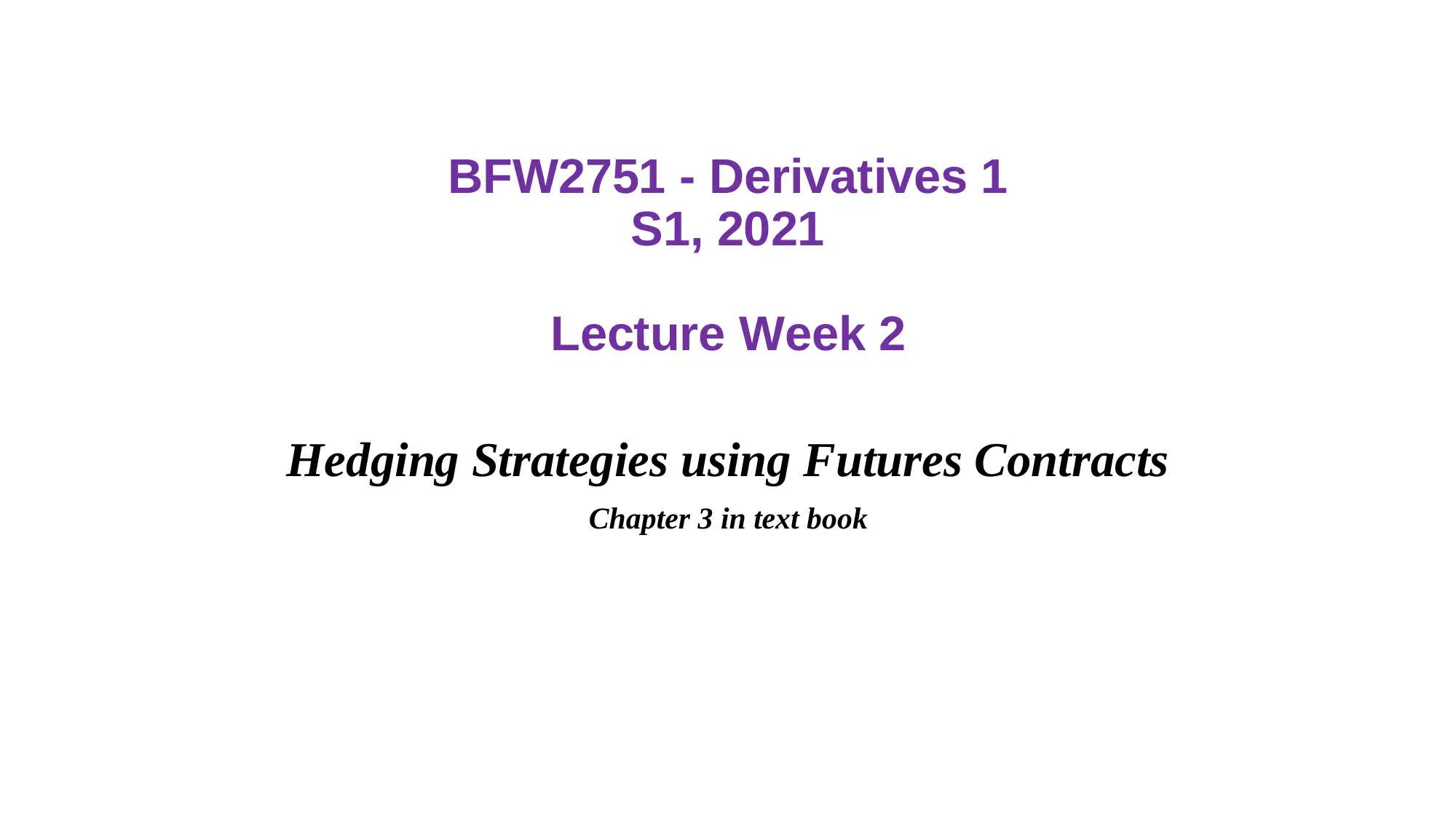
BFW2751 - Derivatives 1
S1, 2021
Lecture Week 2
Hedging Strategies using Futures Contracts
Chapter 3 in text book
S1, 2021
Lecture Week 2
Hedging Strategies using Futures Contracts
Chapter 3 in text book
Paraphrase This Document
Need a fresh take? Get an instant paraphrase of this document with our AI Paraphraser
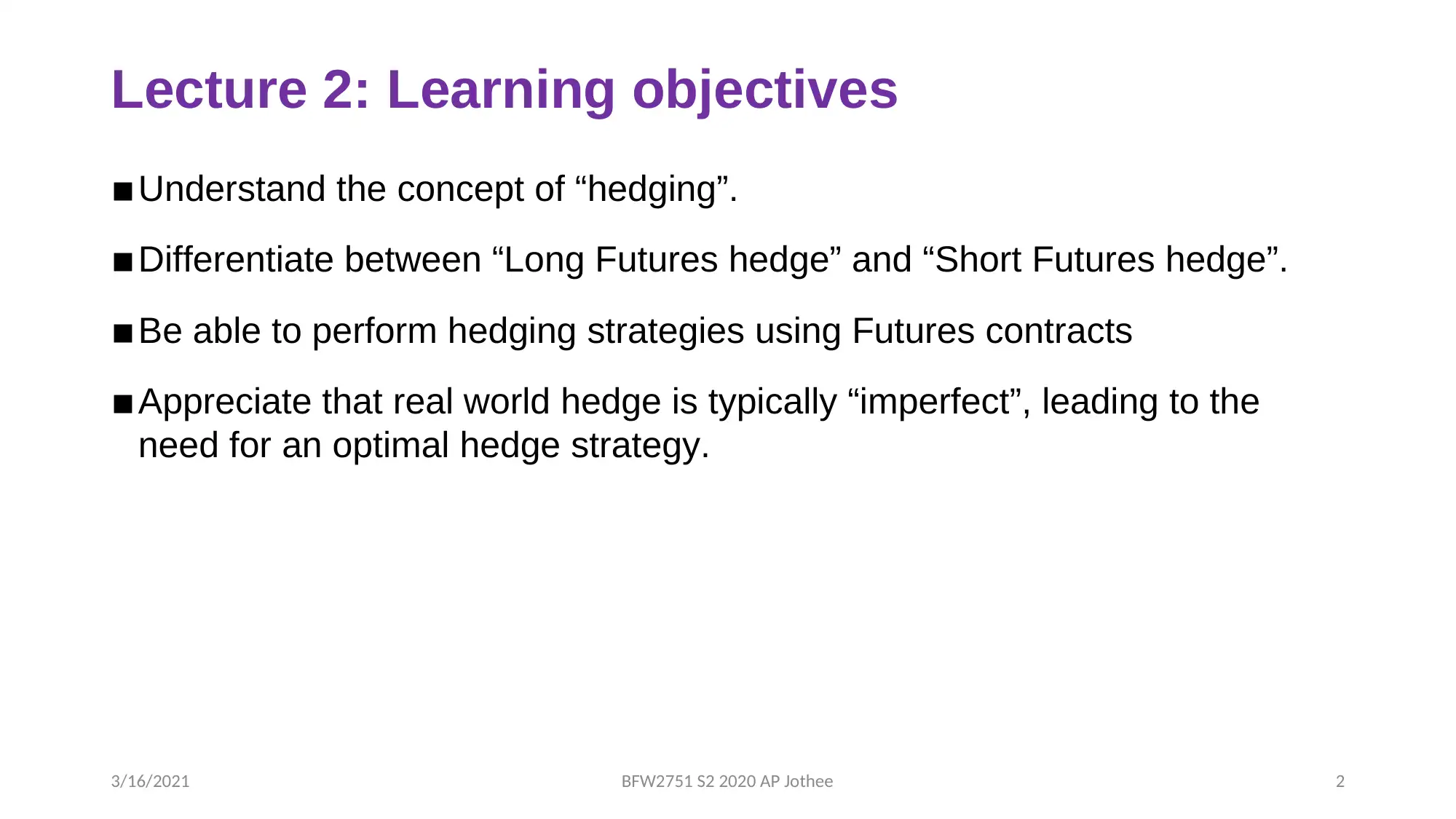
Lecture 2: Learning objectives
▪Understand the concept of “hedging”.
▪Differentiate between “Long Futures hedge” and “Short Futures hedge”.
▪Be able to perform hedging strategies using Futures contracts
▪Appreciate that real world hedge is typically “imperfect”, leading to the
need for an optimal hedge strategy.
3/16/2021 BFW2751 S2 2020 AP Jothee 2
▪Understand the concept of “hedging”.
▪Differentiate between “Long Futures hedge” and “Short Futures hedge”.
▪Be able to perform hedging strategies using Futures contracts
▪Appreciate that real world hedge is typically “imperfect”, leading to the
need for an optimal hedge strategy.
3/16/2021 BFW2751 S2 2020 AP Jothee 2
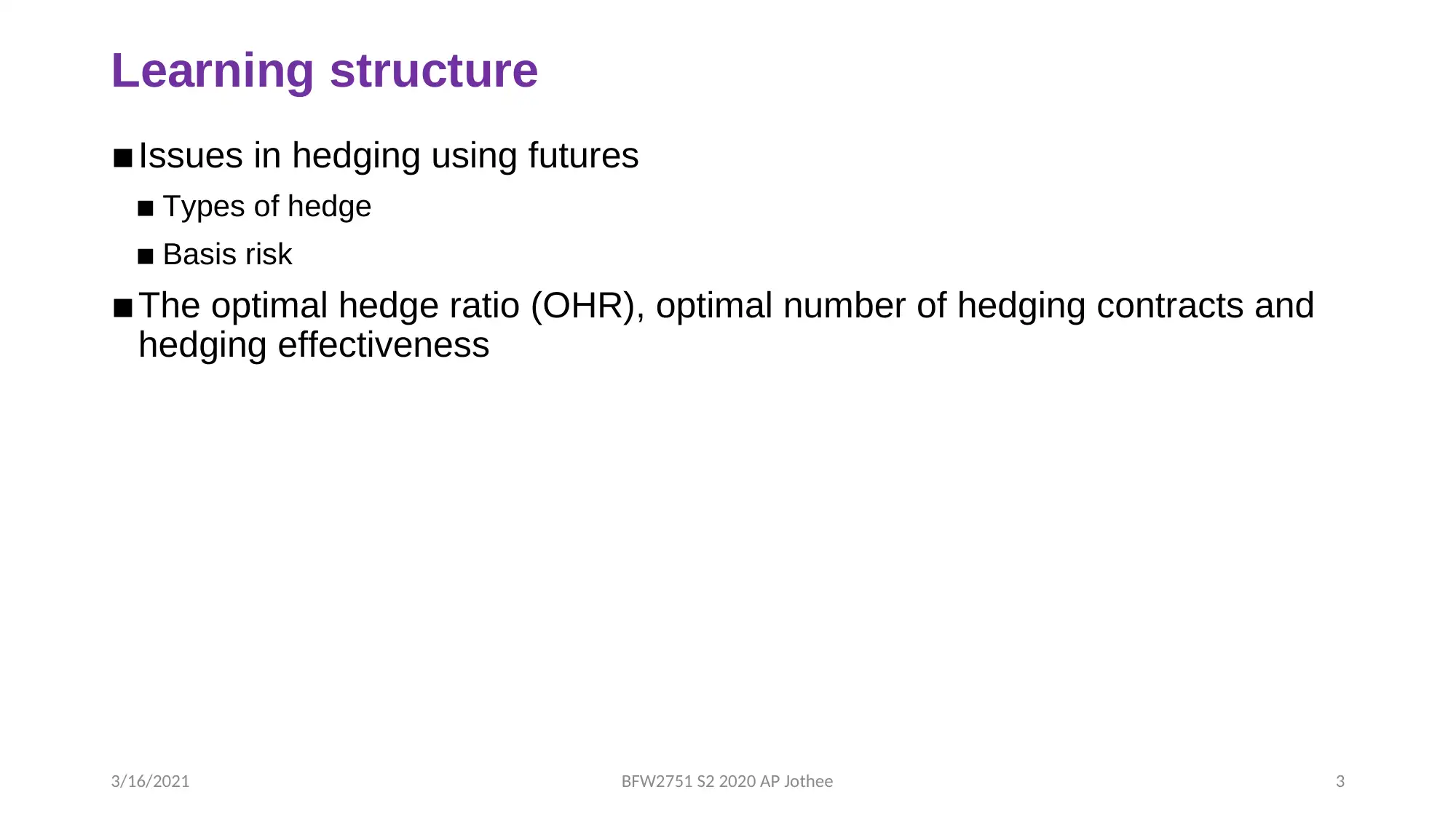
Learning structure
▪Issues in hedging using futures
▪ Types of hedge
▪ Basis risk
▪The optimal hedge ratio (OHR), optimal number of hedging contracts and
hedging effectiveness
3/16/2021 BFW2751 S2 2020 AP Jothee 3
▪Issues in hedging using futures
▪ Types of hedge
▪ Basis risk
▪The optimal hedge ratio (OHR), optimal number of hedging contracts and
hedging effectiveness
3/16/2021 BFW2751 S2 2020 AP Jothee 3
⊘ This is a preview!⊘
Do you want full access?
Subscribe today to unlock all pages.

Trusted by 1+ million students worldwide
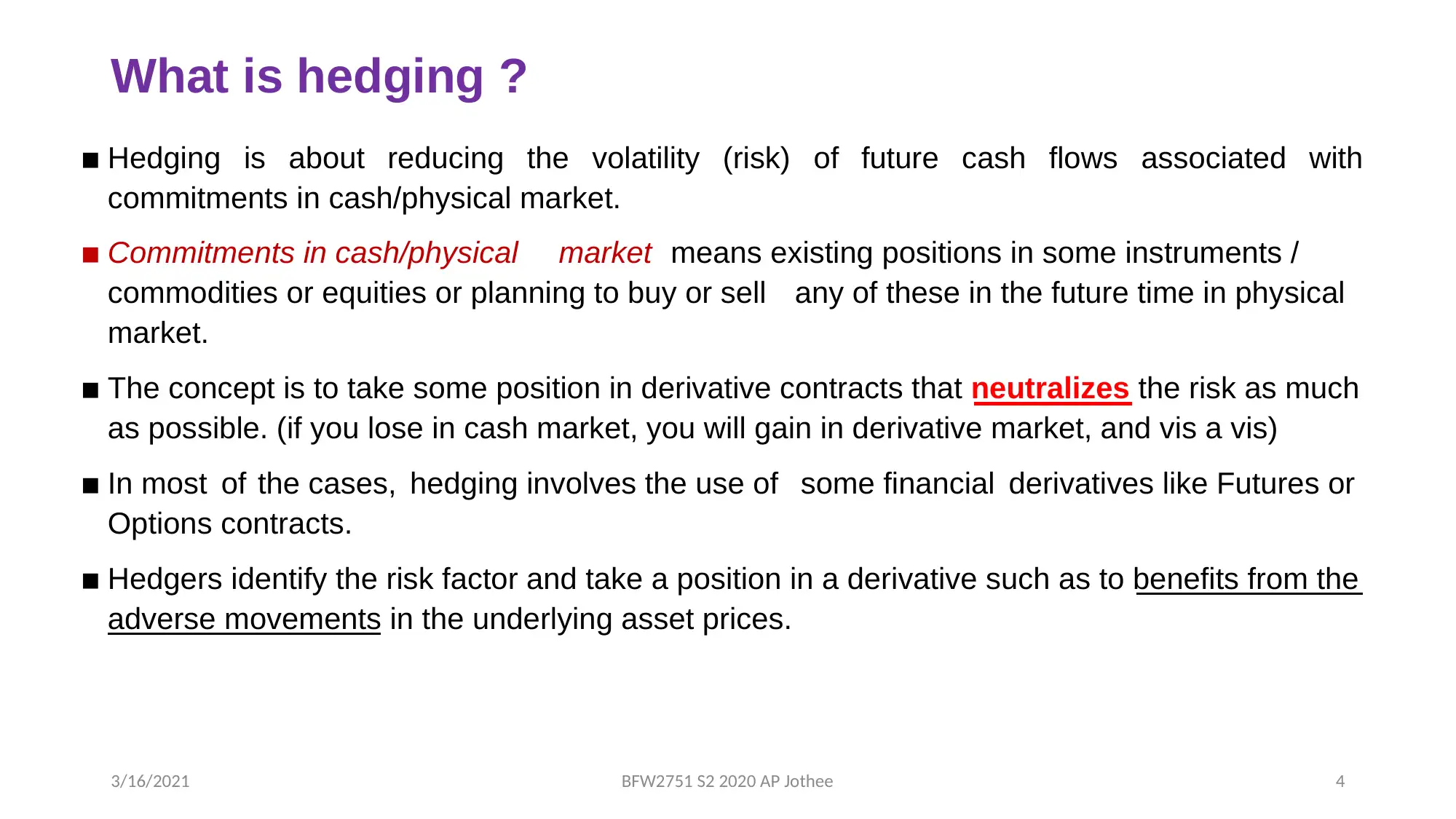
What is hedging ?
▪ Hedging is about reducing the volatility (risk) of future cash flows associated with
commitments in cash/physical market.
▪ Commitments in cash/physical market means existing positions in some instruments /
commodities or equities or planning to buy or sell any of these in the future time in physical
market.
▪ The concept is to take some position in derivative contracts that neutralizes the risk as much
as possible. (if you lose in cash market, you will gain in derivative market, and vis a vis)
▪ In most of the cases, hedging involves the use of some financial derivatives like Futures or
Options contracts.
▪ Hedgers identify the risk factor and take a position in a derivative such as to benefits from the
adverse movements in the underlying asset prices.
3/16/2021 BFW2751 S2 2020 AP Jothee 4
▪ Hedging is about reducing the volatility (risk) of future cash flows associated with
commitments in cash/physical market.
▪ Commitments in cash/physical market means existing positions in some instruments /
commodities or equities or planning to buy or sell any of these in the future time in physical
market.
▪ The concept is to take some position in derivative contracts that neutralizes the risk as much
as possible. (if you lose in cash market, you will gain in derivative market, and vis a vis)
▪ In most of the cases, hedging involves the use of some financial derivatives like Futures or
Options contracts.
▪ Hedgers identify the risk factor and take a position in a derivative such as to benefits from the
adverse movements in the underlying asset prices.
3/16/2021 BFW2751 S2 2020 AP Jothee 4
Paraphrase This Document
Need a fresh take? Get an instant paraphrase of this document with our AI Paraphraser
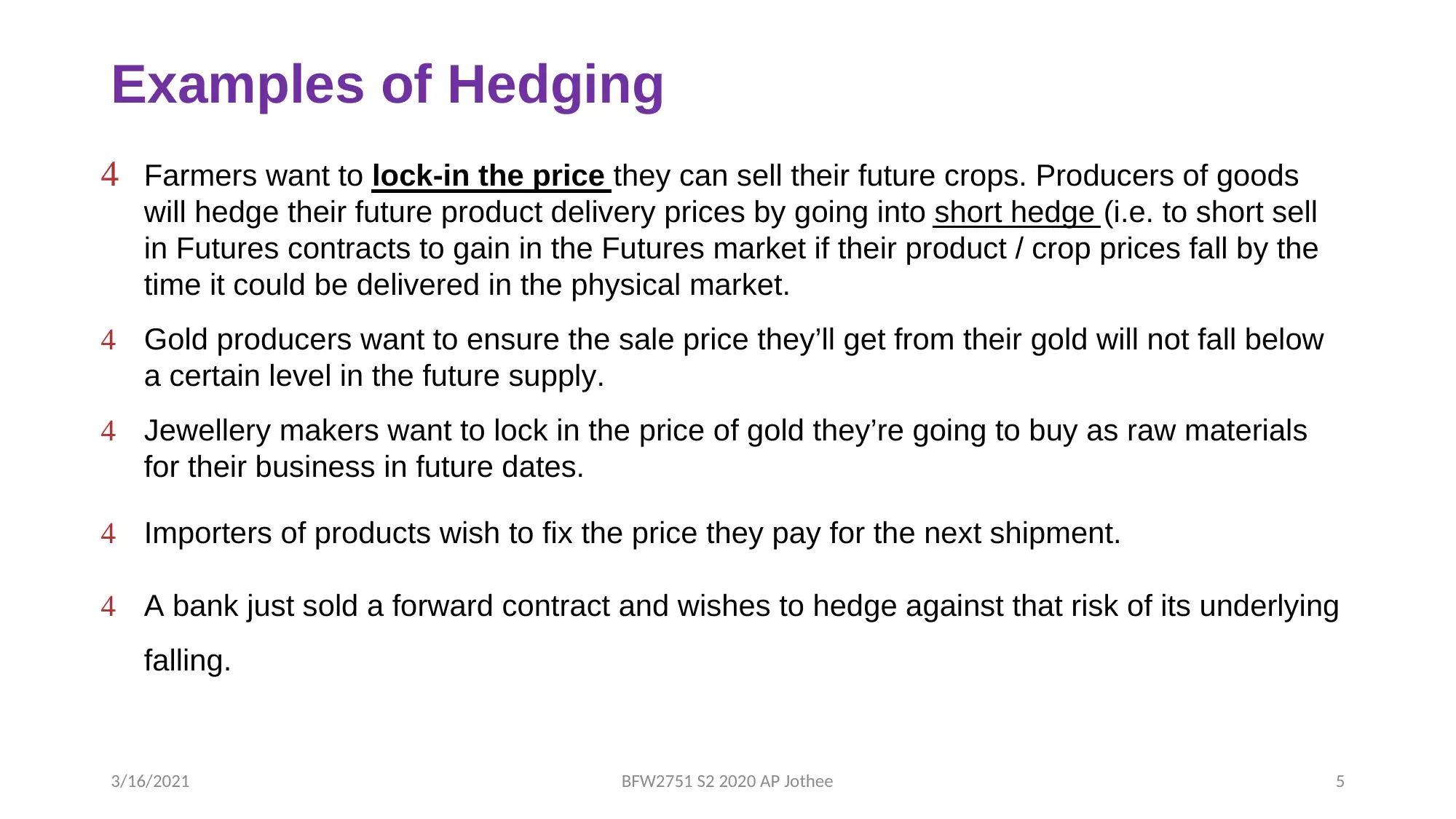
Examples of Hedging
Farmers want to lock-in the price they can sell their future crops. Producers of goods
will hedge their future product delivery prices by going into short hedge (i.e. to short sell
in Futures contracts to gain in the Futures market if their product / crop prices fall by the
time it could be delivered in the physical market.
Gold producers want to ensure the sale price they’ll get from their gold will not fall below
a certain level in the future supply.
Jewellery makers want to lock in the price of gold they’re going to buy as raw materials
for their business in future dates.
Importers of products wish to fix the price they pay for the next shipment.
A bank just sold a forward contract and wishes to hedge against that risk of its underlying
falling.
3/16/2021 BFW2751 S2 2020 AP Jothee 5
Farmers want to lock-in the price they can sell their future crops. Producers of goods
will hedge their future product delivery prices by going into short hedge (i.e. to short sell
in Futures contracts to gain in the Futures market if their product / crop prices fall by the
time it could be delivered in the physical market.
Gold producers want to ensure the sale price they’ll get from their gold will not fall below
a certain level in the future supply.
Jewellery makers want to lock in the price of gold they’re going to buy as raw materials
for their business in future dates.
Importers of products wish to fix the price they pay for the next shipment.
A bank just sold a forward contract and wishes to hedge against that risk of its underlying
falling.
3/16/2021 BFW2751 S2 2020 AP Jothee 5

Long & Short Futures hedges
▪A Long Futures hedge is appropriate when you want to purchase an asset
in the future date and intend to neutralize the risk of increase in price of the
asset by taking a long position in the Futures market. (Long Futures hedge
when asset price may rise at future time).
▪A Short Futures hedge is appropriate when you want to sell an asset in the
future date and intend to neutralize the risk of fall in price of the asset by
taking a short position in the Futures market. (Short Futures hedge when
asset price may fall in future time).
3/16/2021 BFW2751 S2 2020 AP Jothee 6
▪A Long Futures hedge is appropriate when you want to purchase an asset
in the future date and intend to neutralize the risk of increase in price of the
asset by taking a long position in the Futures market. (Long Futures hedge
when asset price may rise at future time).
▪A Short Futures hedge is appropriate when you want to sell an asset in the
future date and intend to neutralize the risk of fall in price of the asset by
taking a short position in the Futures market. (Short Futures hedge when
asset price may fall in future time).
3/16/2021 BFW2751 S2 2020 AP Jothee 6
⊘ This is a preview!⊘
Do you want full access?
Subscribe today to unlock all pages.

Trusted by 1+ million students worldwide
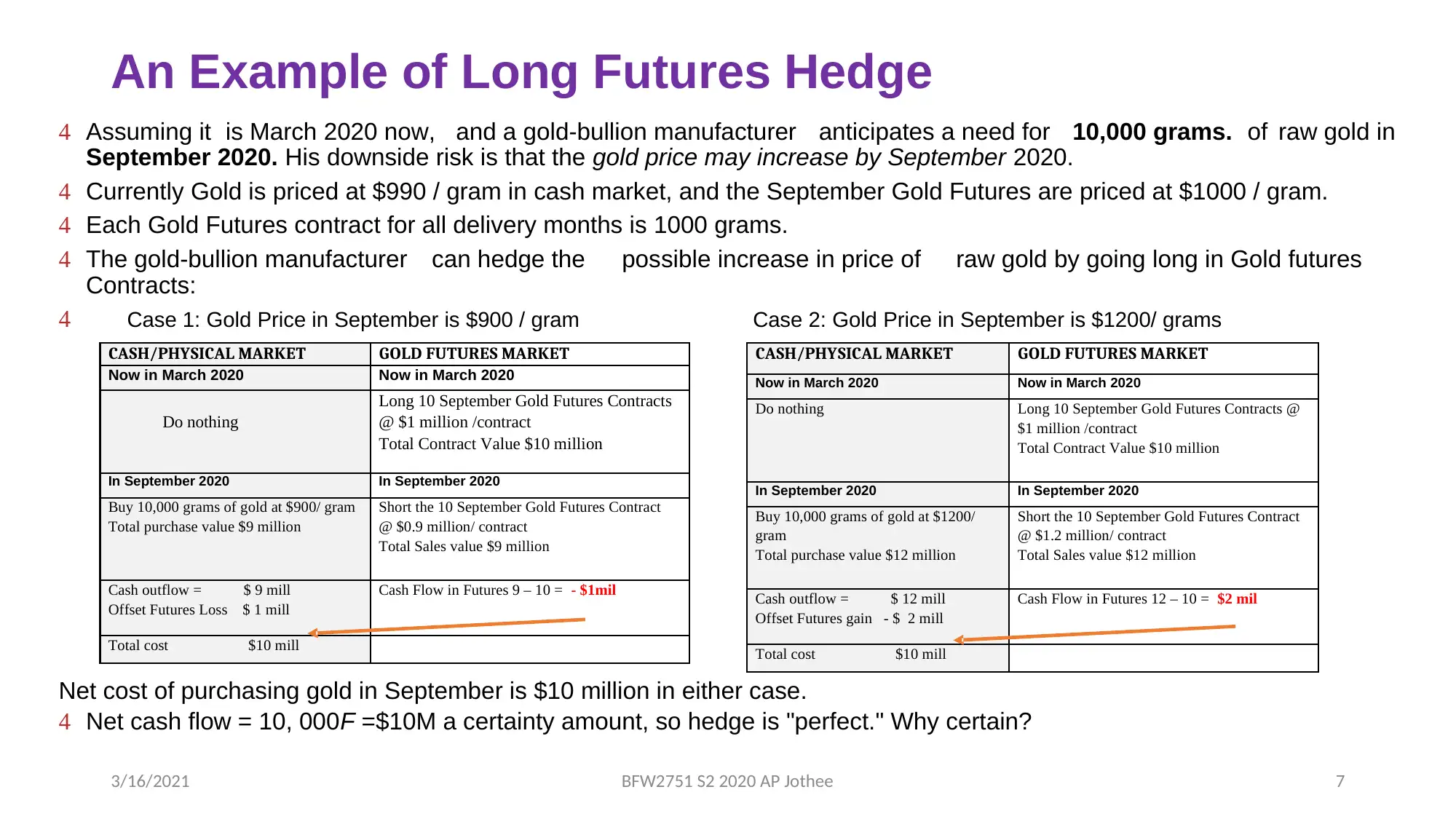
An Example of Long Futures Hedge
Assuming it is March 2020 now, and a gold-bullion manufacturer anticipates a need for 10,000 grams. of raw gold in
September 2020. His downside risk is that the gold price may increase by September 2020.
Currently Gold is priced at $990 / gram in cash market, and the September Gold Futures are priced at $1000 / gram.
Each Gold Futures contract for all delivery months is 1000 grams.
The gold-bullion manufacturer can hedge the possible increase in price of raw gold by going long in Gold futures
Contracts:
Case 1: Gold Price in September is $900 / gram Case 2: Gold Price in September is $1200/ grams
Net cost of purchasing gold in September is $10 million in either case.
Net cash flow = 10, 000F =$10M a certainty amount, so hedge is "perfect." Why certain?
3/16/2021 BFW2751 S2 2020 AP Jothee 7
CASH/PHYSICAL MARKET GOLD FUTURES MARKET
Now in March 2020 Now in March 2020
Do nothing
Long 10 September Gold Futures Contracts
@ $1 million /contract
Total Contract Value $10 million
In September 2020 In September 2020
Buy 10,000 grams of gold at $900/ gram
Total purchase value $9 million
Short the 10 September Gold Futures Contract
@ $0.9 million/ contract
Total Sales value $9 million
Cash outflow = $ 9 mill
Offset Futures Loss $ 1 mill
Cash Flow in Futures 9 – 10 = - $1mil
Total cost $10 mill
CASH/PHYSICAL MARKET GOLD FUTURES MARKET
Now in March 2020 Now in March 2020
Do nothing Long 10 September Gold Futures Contracts @
$1 million /contract
Total Contract Value $10 million
In September 2020 In September 2020
Buy 10,000 grams of gold at $1200/
gram
Total purchase value $12 million
Short the 10 September Gold Futures Contract
@ $1.2 million/ contract
Total Sales value $12 million
Cash outflow = $ 12 mill
Offset Futures gain - $ 2 mill
Cash Flow in Futures 12 – 10 = $2 mil
Total cost $10 mill
Assuming it is March 2020 now, and a gold-bullion manufacturer anticipates a need for 10,000 grams. of raw gold in
September 2020. His downside risk is that the gold price may increase by September 2020.
Currently Gold is priced at $990 / gram in cash market, and the September Gold Futures are priced at $1000 / gram.
Each Gold Futures contract for all delivery months is 1000 grams.
The gold-bullion manufacturer can hedge the possible increase in price of raw gold by going long in Gold futures
Contracts:
Case 1: Gold Price in September is $900 / gram Case 2: Gold Price in September is $1200/ grams
Net cost of purchasing gold in September is $10 million in either case.
Net cash flow = 10, 000F =$10M a certainty amount, so hedge is "perfect." Why certain?
3/16/2021 BFW2751 S2 2020 AP Jothee 7
CASH/PHYSICAL MARKET GOLD FUTURES MARKET
Now in March 2020 Now in March 2020
Do nothing
Long 10 September Gold Futures Contracts
@ $1 million /contract
Total Contract Value $10 million
In September 2020 In September 2020
Buy 10,000 grams of gold at $900/ gram
Total purchase value $9 million
Short the 10 September Gold Futures Contract
@ $0.9 million/ contract
Total Sales value $9 million
Cash outflow = $ 9 mill
Offset Futures Loss $ 1 mill
Cash Flow in Futures 9 – 10 = - $1mil
Total cost $10 mill
CASH/PHYSICAL MARKET GOLD FUTURES MARKET
Now in March 2020 Now in March 2020
Do nothing Long 10 September Gold Futures Contracts @
$1 million /contract
Total Contract Value $10 million
In September 2020 In September 2020
Buy 10,000 grams of gold at $1200/
gram
Total purchase value $12 million
Short the 10 September Gold Futures Contract
@ $1.2 million/ contract
Total Sales value $12 million
Cash outflow = $ 12 mill
Offset Futures gain - $ 2 mill
Cash Flow in Futures 12 – 10 = $2 mil
Total cost $10 mill
Paraphrase This Document
Need a fresh take? Get an instant paraphrase of this document with our AI Paraphraser

• A Motivating Example (Outcome)
Alternative explanation: consider the outcomes from 2 different scenarios in September
2020
Try again with any ST value, you always get 10M.
Why?
Well, any gain (loss) from the spot transaction is exactly matched by loss (gain) from the
futures transaction, as long as ST=FT. This “exactness” makes the hedge perfect.
Scenario 1: ST=FT =900 Scenario 2: ST=FT =1200
Price paid for gold on
the spot market in Sept.
10,000 x 900 = 9M 10,000x1200=12M
Less payoff from futures
(You go short in
September 2020.)
10,000(FT -F)
=10,000 (900-1000)
=-1M
10,000(FT -F)
=10,000(1200-1000)
=+2M
Net price paid for gold
By offsetting the
gain/loss in futures
9M + 1M = 10M 12M – 2M = 10M
3/16/2021 BFW2751 S2 2020 AP Jothee 8
Alternative explanation: consider the outcomes from 2 different scenarios in September
2020
Try again with any ST value, you always get 10M.
Why?
Well, any gain (loss) from the spot transaction is exactly matched by loss (gain) from the
futures transaction, as long as ST=FT. This “exactness” makes the hedge perfect.
Scenario 1: ST=FT =900 Scenario 2: ST=FT =1200
Price paid for gold on
the spot market in Sept.
10,000 x 900 = 9M 10,000x1200=12M
Less payoff from futures
(You go short in
September 2020.)
10,000(FT -F)
=10,000 (900-1000)
=-1M
10,000(FT -F)
=10,000(1200-1000)
=+2M
Net price paid for gold
By offsetting the
gain/loss in futures
9M + 1M = 10M 12M – 2M = 10M
3/16/2021 BFW2751 S2 2020 AP Jothee 8
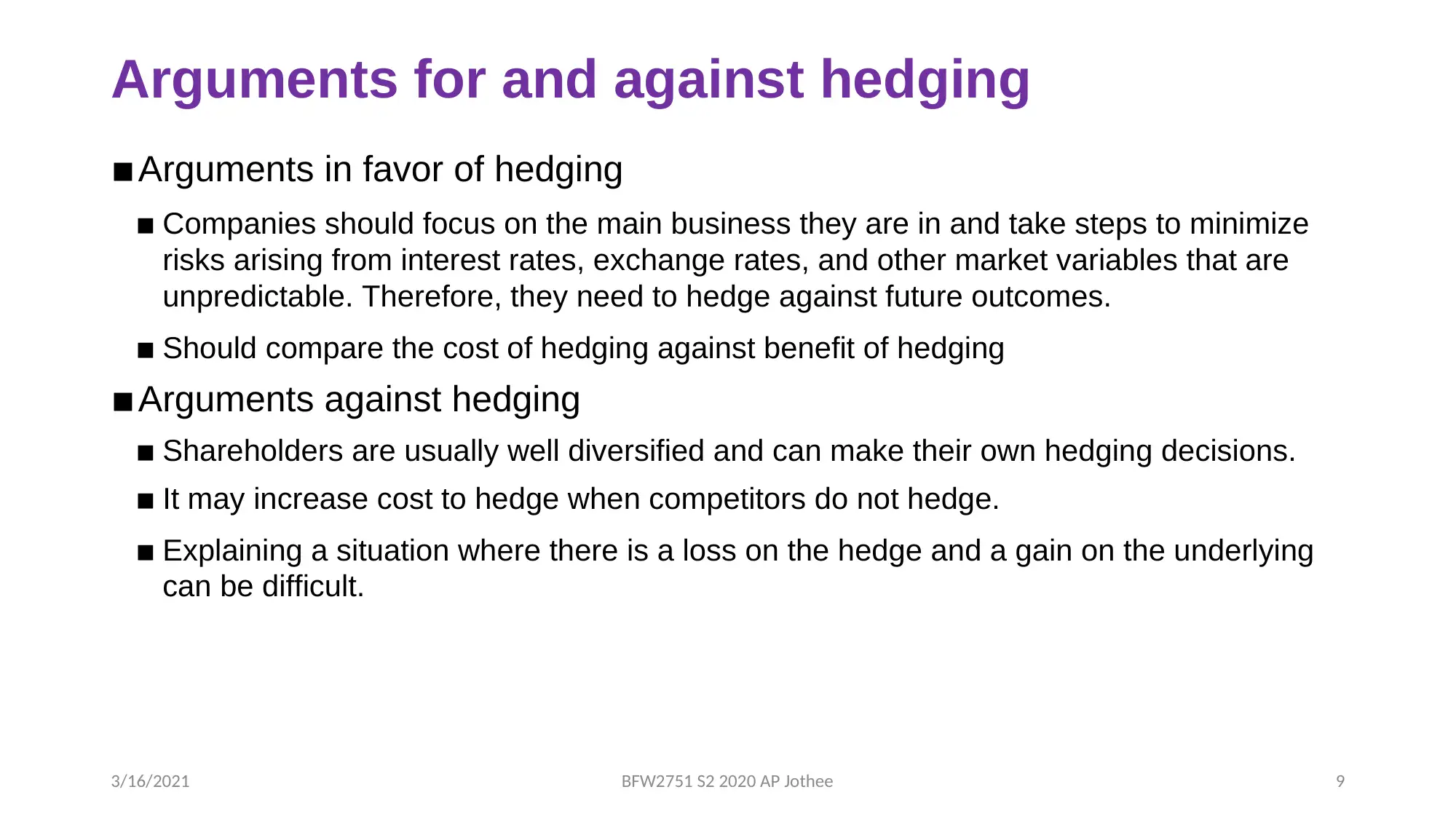
Arguments for and against hedging
▪Arguments in favor of hedging
▪ Companies should focus on the main business they are in and take steps to minimize
risks arising from interest rates, exchange rates, and other market variables that are
unpredictable. Therefore, they need to hedge against future outcomes.
▪ Should compare the cost of hedging against benefit of hedging
▪Arguments against hedging
▪ Shareholders are usually well diversified and can make their own hedging decisions.
▪ It may increase cost to hedge when competitors do not hedge.
▪ Explaining a situation where there is a loss on the hedge and a gain on the underlying
can be difficult.
3/16/2021 BFW2751 S2 2020 AP Jothee 9
▪Arguments in favor of hedging
▪ Companies should focus on the main business they are in and take steps to minimize
risks arising from interest rates, exchange rates, and other market variables that are
unpredictable. Therefore, they need to hedge against future outcomes.
▪ Should compare the cost of hedging against benefit of hedging
▪Arguments against hedging
▪ Shareholders are usually well diversified and can make their own hedging decisions.
▪ It may increase cost to hedge when competitors do not hedge.
▪ Explaining a situation where there is a loss on the hedge and a gain on the underlying
can be difficult.
3/16/2021 BFW2751 S2 2020 AP Jothee 9
⊘ This is a preview!⊘
Do you want full access?
Subscribe today to unlock all pages.

Trusted by 1+ million students worldwide
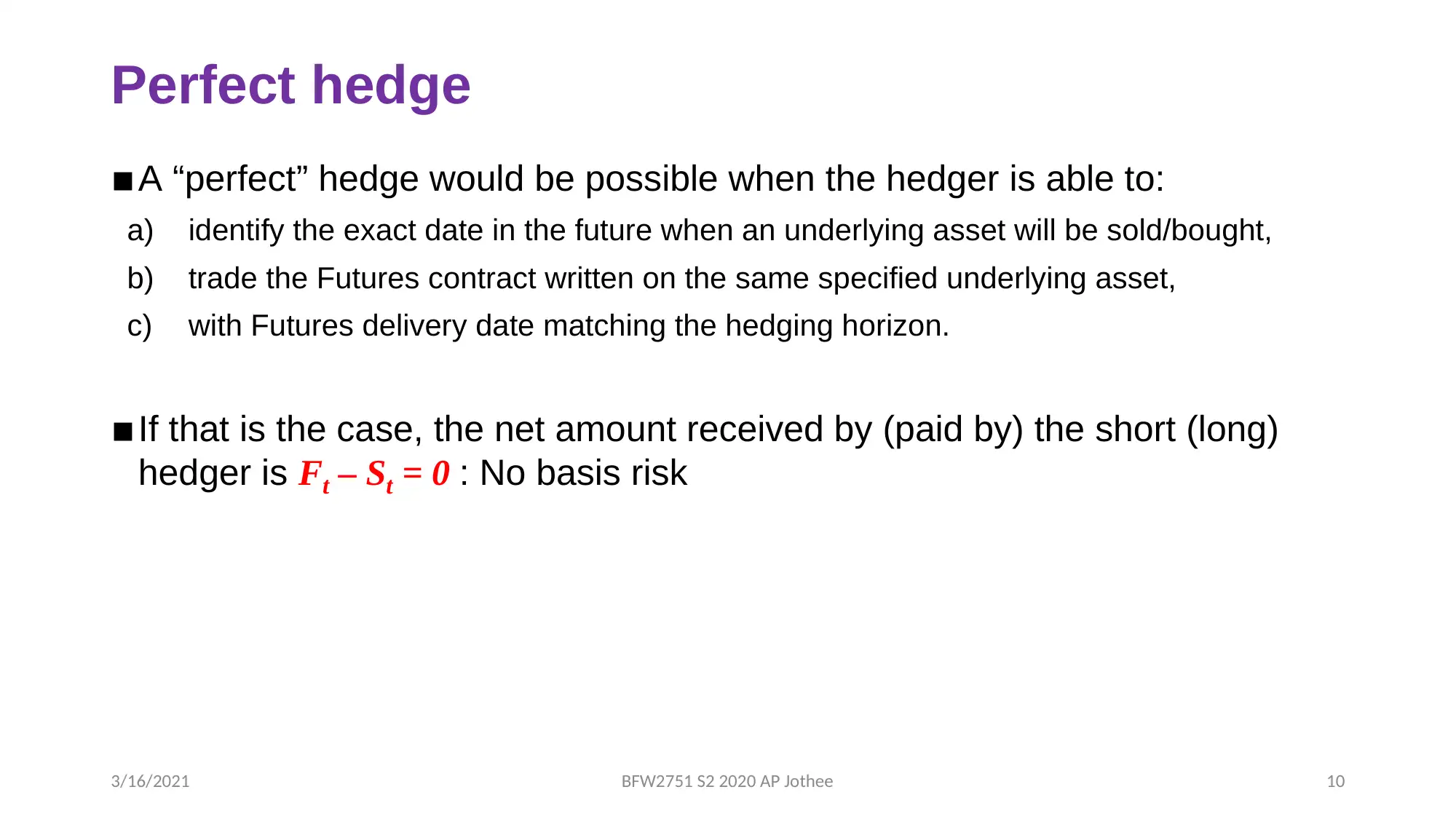
Perfect hedge
▪A “perfect” hedge would be possible when the hedger is able to:
a) identify the exact date in the future when an underlying asset will be sold/bought,
b) trade the Futures contract written on the same specified underlying asset,
c) with Futures delivery date matching the hedging horizon.
▪If that is the case, the net amount received by (paid by) the short (long)
hedger is Ft – St = 0 : No basis risk
3/16/2021 BFW2751 S2 2020 AP Jothee 10
▪A “perfect” hedge would be possible when the hedger is able to:
a) identify the exact date in the future when an underlying asset will be sold/bought,
b) trade the Futures contract written on the same specified underlying asset,
c) with Futures delivery date matching the hedging horizon.
▪If that is the case, the net amount received by (paid by) the short (long)
hedger is Ft – St = 0 : No basis risk
3/16/2021 BFW2751 S2 2020 AP Jothee 10
Paraphrase This Document
Need a fresh take? Get an instant paraphrase of this document with our AI Paraphraser
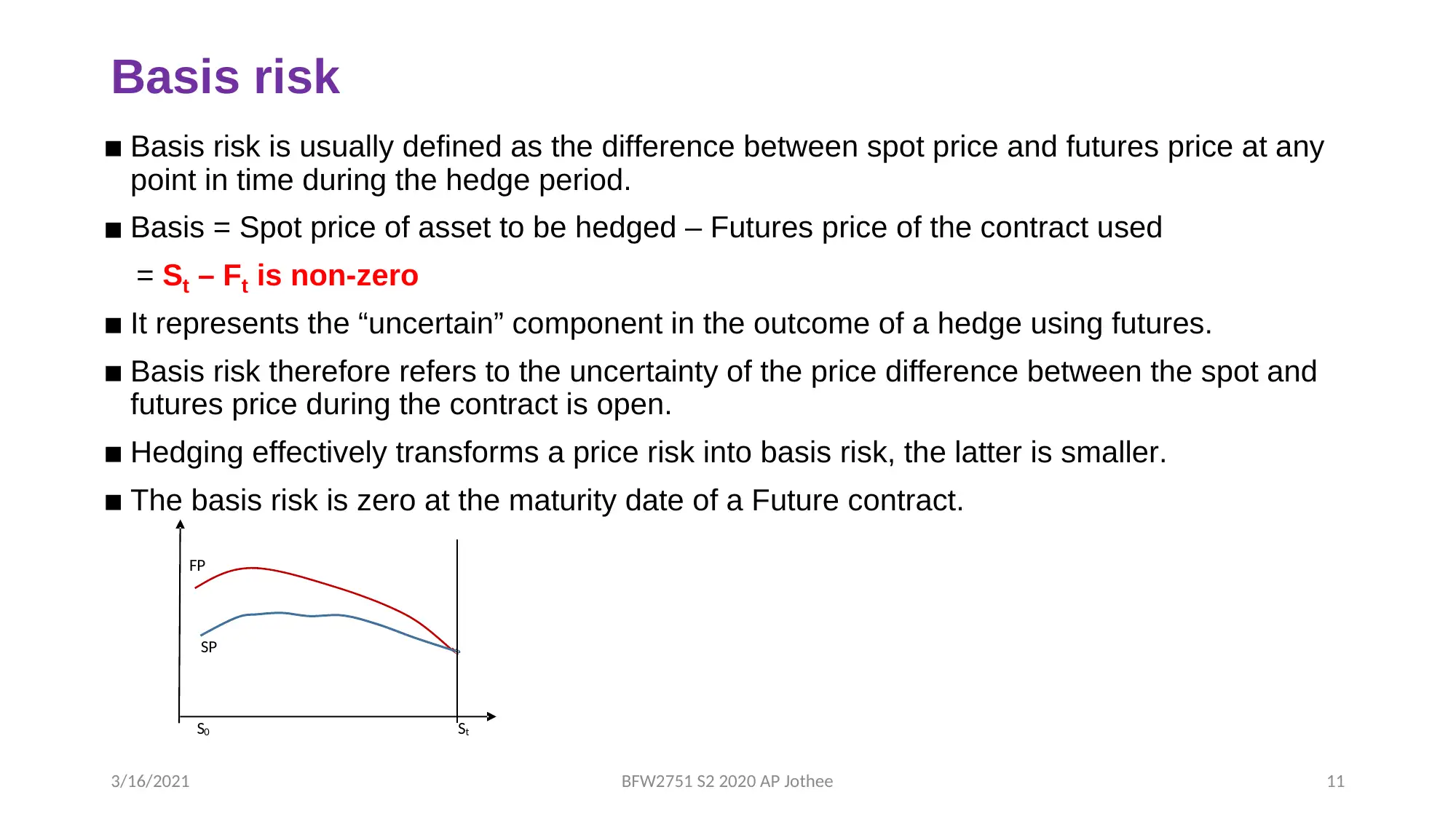
Basis risk
▪ Basis risk is usually defined as the difference between spot price and futures price at any
point in time during the hedge period.
▪ Basis = Spot price of asset to be hedged – Futures price of the contract used
= St – Ft is non-zero
▪ It represents the “uncertain” component in the outcome of a hedge using futures.
▪ Basis risk therefore refers to the uncertainty of the price difference between the spot and
futures price during the contract is open.
▪ Hedging effectively transforms a price risk into basis risk, the latter is smaller.
▪ The basis risk is zero at the maturity date of a Future contract.
3/16/2021 BFW2751 S2 2020 AP Jothee 11
FP
SP
S0 St
▪ Basis risk is usually defined as the difference between spot price and futures price at any
point in time during the hedge period.
▪ Basis = Spot price of asset to be hedged – Futures price of the contract used
= St – Ft is non-zero
▪ It represents the “uncertain” component in the outcome of a hedge using futures.
▪ Basis risk therefore refers to the uncertainty of the price difference between the spot and
futures price during the contract is open.
▪ Hedging effectively transforms a price risk into basis risk, the latter is smaller.
▪ The basis risk is zero at the maturity date of a Future contract.
3/16/2021 BFW2751 S2 2020 AP Jothee 11
FP
SP
S0 St
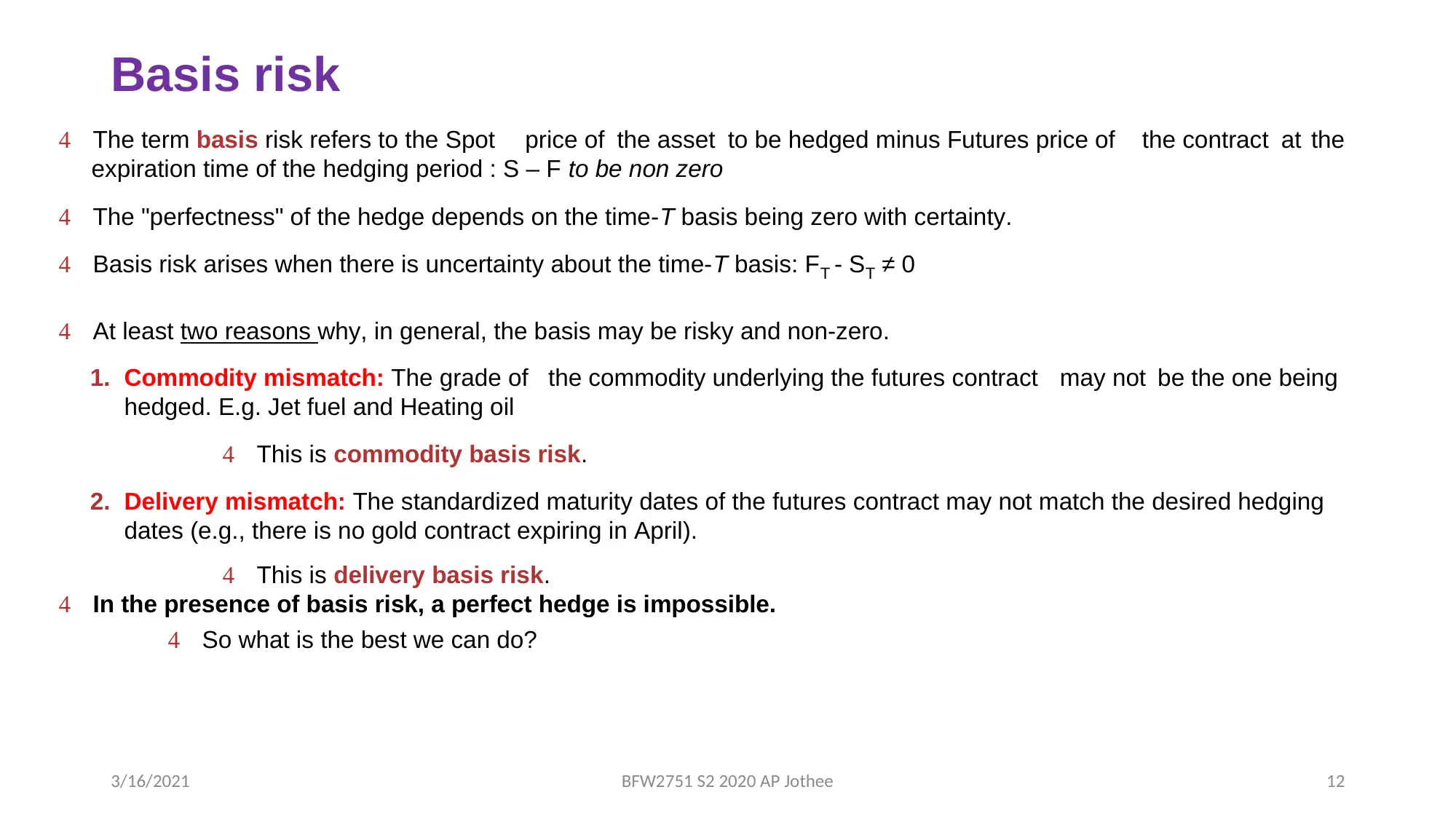
Basis risk
The term basis risk refers to the Spot price of the asset to be hedged minus Futures price of the contract at the
expiration time of the hedging period : S – F to be non zero
The "perfectness" of the hedge depends on the time-T basis being zero with certainty.
Basis risk arises when there is uncertainty about the time-T basis: FT - ST ≠ 0
At least two reasons why, in general, the basis may be risky and non-zero.
1. Commodity mismatch: The grade of the commodity underlying the futures contract may not be the one being
hedged. E.g. Jet fuel and Heating oil
This is commodity basis risk.
2. Delivery mismatch: The standardized maturity dates of the futures contract may not match the desired hedging
dates (e.g., there is no gold contract expiring in April).
This is delivery basis risk.
In the presence of basis risk, a perfect hedge is impossible.
So what is the best we can do?
3/16/2021 BFW2751 S2 2020 AP Jothee 12
The term basis risk refers to the Spot price of the asset to be hedged minus Futures price of the contract at the
expiration time of the hedging period : S – F to be non zero
The "perfectness" of the hedge depends on the time-T basis being zero with certainty.
Basis risk arises when there is uncertainty about the time-T basis: FT - ST ≠ 0
At least two reasons why, in general, the basis may be risky and non-zero.
1. Commodity mismatch: The grade of the commodity underlying the futures contract may not be the one being
hedged. E.g. Jet fuel and Heating oil
This is commodity basis risk.
2. Delivery mismatch: The standardized maturity dates of the futures contract may not match the desired hedging
dates (e.g., there is no gold contract expiring in April).
This is delivery basis risk.
In the presence of basis risk, a perfect hedge is impossible.
So what is the best we can do?
3/16/2021 BFW2751 S2 2020 AP Jothee 12
⊘ This is a preview!⊘
Do you want full access?
Subscribe today to unlock all pages.

Trusted by 1+ million students worldwide
1 out of 32
Your All-in-One AI-Powered Toolkit for Academic Success.
+13062052269
info@desklib.com
Available 24*7 on WhatsApp / Email
![[object Object]](/_next/static/media/star-bottom.7253800d.svg)
Unlock your academic potential
Copyright © 2020–2025 A2Z Services. All Rights Reserved. Developed and managed by ZUCOL.


